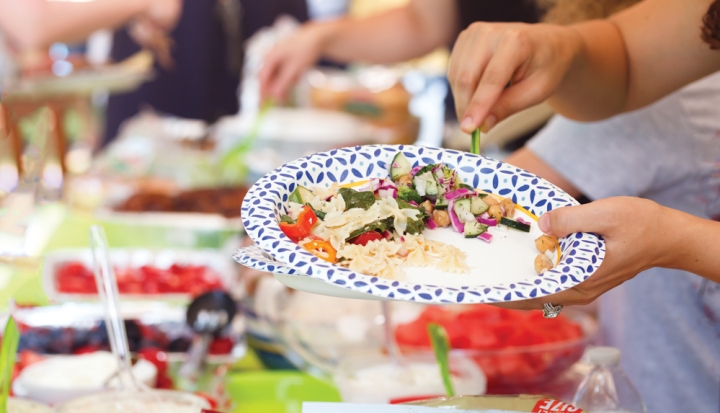“What is your favorite Jesus story? And why?” A dozen women gave quick answers. I said, “Jesus grilling breakfast for the disciples. ‘Come and dine.’ It connects him with me, especially when I’m in the kitchen with a neighbor teen; ‘Nina’ comes over and we cook together, especially on Saturday mornings.”
But the follow-up question stumped us: “Tell us a story about yourself that illustrates what you want to be remembered for.” Disconcerted, most of us named a positive attribute of someone across the room. Maureen smiled at me. “I appreciate Evelyn’s holiday hospitality. The invitations mean a lot.”
I haven’t always opened my home on holidays. I’ve been welcomed by gracious hosts. I’ve sometimes been alone. But, indeed, Maureen has dined at my Easter table for several years now, beginning back when young Nina was new on my street and a forceful presence in the neighborhood. Guests still reminisce, reminding me of the scene. I hadn’t opened the door to the 7-year-old whose life was and is complicated by cognitive impairment and her family’s ongoing acculturation from Central America. Even so, she vicariously enjoyed that Sunday’s festivities—gaping at the tableful of guests through the front-door mail slot. “She’s curious,” I told guests. “A quiet dinner party may be a novelty to her. Let her watch. I hope you don’t mind,” though their furtive glances betrayed their slight discomfort—aware of the big, brown, spying eyes.
In From Tablet to Table, Leonard Sweet positively compares a lively table to a “place of fireworks,” in that ideas can “diffuse, spread, and intermingle, producing energy” at new heights. With little effort on my part, the conversation that day soared—maybe not sky-high, but laughter lit by one personal story or viewpoint followed by another. Conviviality from cheesy hors d’oeuvres to after-dinner chocolates kindled a resolve—to make a few annual holidays happen by reaching out and inviting in.
Over the intervening years, Nina has stepped across the threshold and helped me prepare for table guests. She’s arranged place settings with the “good” dishes. At Thanksgiving she’s broken dried bread for stuffing. Catching the vision, she’s invited me to “come and dine.” A few Thanksgivings, when I wasn’t cooking for others, she has insisted: “You come over and eat our turkey with us”—adobo-spiced with rice and tortillas. Though Thanksgiving isn’t a holiday in their native country, her family is happy to buy into and modify a uniquely American tradition.
Last Thanksgiving, at my own table, I sparked a conversation about holidays. “They’re so arbitrary. For my friends in Canada, it’s just an ordinary Thursday. We say a day is special—therefore it is! Does every culture set aside days for feasts or worship or games?”
I mentioned the Hebrew festivals, commemorating miracles and harvests. A woman with Pueblo roots chimed in. “The tribal lore sees seasonal celebrations, especially Shalako in the fall, as reward for hard work and ‘fuel’ for the winter ahead. We share harvests, bless new homes, celebrate births. . . . It’s a community affair.” Yes, we agreed. Different days for different lands, but, as Alexander Schmemann notes, there’s a “fundamentally human phenomenon of feast”—meant to be shared.
On July 3, 1776, John Adams wrote home to his wife, Abigail, imagining that a “great anniversary festival” would be commemorated by prayers and “pomp and parade . . . and illuminations” across the continent “from this time forward forever more.”
About Memorial Day last year, I started hearing a complaint from Nina: “You’ve never invited my family for dinner.” True—for reasons including the language barrier and a rambunctious younger sibling. Then she got more specific. “How about July 4? Can we?” Yes.
So I invited them—Grandmother, Mom, and two daughters. No longer on the outside looking in, Nina, now a young teen, initiated plans. She wrote headings on individual menus: “Today we will have.” From a library cookbook, she copied a recipe for ice cream-Oreo cake. “Can we make it?” Yes, we can experiment.
“Give me three dinner ideas,” I said. We settled on spiral pasta, corn on the cob, fruit salad, and tossed salad. We shopped together. She made meatballs and chopped fruit and vegetables. I husked corn. She set the table. “The company silverware, from the box?” Yes.
Our teamwork worked. At 6:20 on July 4, we sat down. I congratulated Mom on her new citizen status. Nina and I sang our standard breakfast grace, “The Lord is good to me . . .” We spooned out and dug in. Conversation was cordial if spotty and bolstered by hand gestures. Little sister behaved, mostly, anticipating the frozen cake strewn with red sprinkles. After they left, I cleaned up a colossal mess. I took no pictures. Aside from leftovers and laundry, I found only one memento: a partially drawn flag—red and white stripes—left behind by little sister. I went to bed tired but exhilarated, as if I’d seen a skyful of fireworks.
The next day Nina came by. “I think it was a success,” she said. “Can we do it again next year?” For months now she’s been tweaking the menu.
In Community and Growth, Jean Vanier proposes that celebration “brings hope and a new strength to take up again everyday life with more love.” Maybe that’s why this year my heart says it’s time to take a once-unimaginable leap: “Nina, do you want to be one of the guests for Easter dinner?”
“Yes, I want to come.”
This article also appears in the July 2019 issue of U.S. Catholic (Vol. 84, No. 7, pages 12–16).
Image: iStock














Add comment